Dear reader: This article contains links to products and services that I may be compensated for, at no extra cost to you.
Wulai (烏來, Tayal language: Ulay, which means ‘hot spring’) is the largest district of New Taipei City, but only has around 6000 residents, by far the lowest population density. Officially the only “mountain indigenous district” of New Taipei City, it is home to the closest aboriginal Taiwanese village to Taipei City.
There are many reasons to visit Wulai: Thermal water pools at riverside Wulai Hot Spring, local aboriginal and Taiwanese foods on Wulai Old Street, cherry blossom viewing, cable car ride, wild jungle treks, towering waterfalls, and some of the best river tracing in Northern Taiwan.
Wulai is without a doubt one of the best day trips from Taipei. It is one of my personal favorite places to visit in Taiwan, and I’ve been there over a dozen times!

In this guide, I’m going to cover everything you may need to know for visiting Wulai, including how to get there, things to do in Wulai, what to eat, Wulai hot springs, where to stay if you decide to spend the night, the best hikes in the area, how to go river tracing there, and visiting Wulai with kids.
I’ll be linking to a few discounts and travel deals for visiting Wulai on Klook, so make sure to sign up with this link first and a TWD100 voucher will be applied to your account!
If you’re new to Taiwan, see my Taiwan travel guide for first-timers.
Table of Contents
A Brief History of Wulai, Taipei

Wulai is the southernmost, largest, most mountainous, and least densely populated district of New Taipei City, the sprawling city that surrounds Taipei City. Wulai is the northernmost village of the Atayal (Taiyal tribe or taiya zu / 泰雅族), the third largest of Taiwan’s 16 officially recognized aboriginal tribes.

Other great places to experience Taiwanese aboriginal culture include Sun Moon Lake, Orchid Island, the East Coast of Taiwan, or try this aboriginal cooking course in Hualien.
Nanshi River (南勢溪) flows through Wulai district before spilling into the Xindian River, which then spills into the Tamsui River in Taipei City before making its way to the sea at Tamsui.
Winding Provincial Highway 9 follows the river from Xindian to Wulai Old Street Wulai, providing the only access to the town. Old Street is the tourist center of Wulai District and is located on either side of Nanshi River at the point where Wulai Hot Springs spout from the ground, one of over 100 thermal hot springs in Taiwan.
There is a local legend that when the Atayal first traveled up the Nanshi River Valley and spotted steam hanging in the air, they exclaimed ulay! or “hot spring!” They were the first to settle in the region, and today make up about a third of the population of Wulai district.
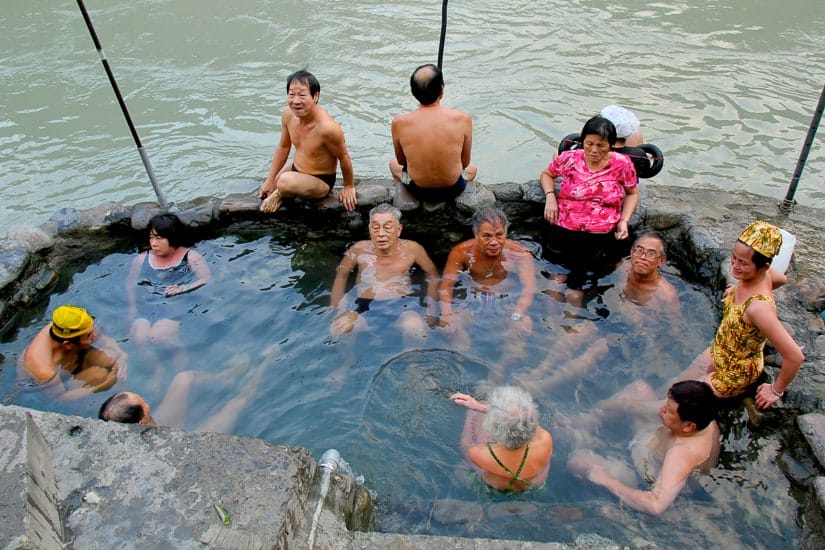
In recent decades, Wulai has grown into a major tourist attraction and very popular day trip for people living in Taipei, being the most accessible aboriginal village from Taiwan’s capital city.
A winding road follows the Nanshi River Valley from Xindian to the collection of tourist amenities and spas centered on Wulai Old Street and Wulai Hot Spring.
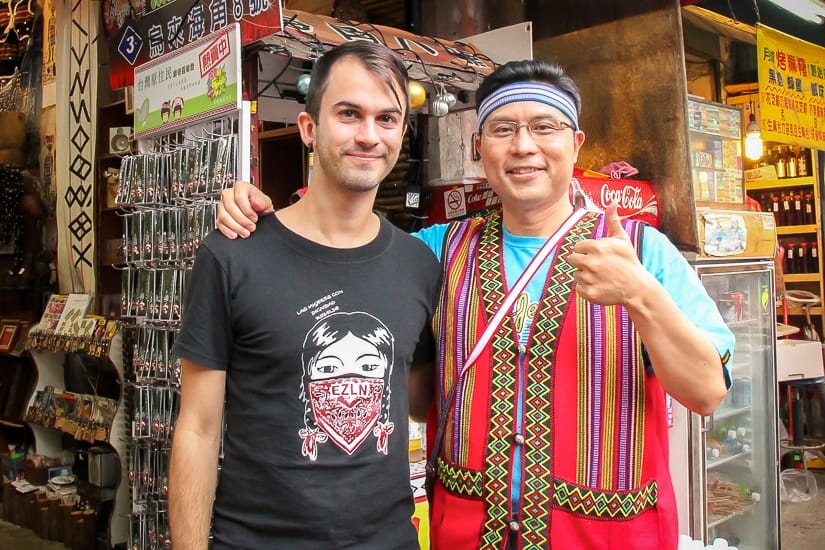
In the last 7 or 8 years, the grungy, rundown collection of hot spring tubs at the riverside in Wulai, once the best part of visiting Wulai, have fallen into disrepair and suffer from lack of water because hot spring hotels in the area pipe all of it out.
They have become recently blocked off in recent years, and in early 2021, the government announced that they are now illegal to visit.

In August of 2015, Typhoon Soudelor wreaked havoc on Wulai, destroying numerous local homes, hotels, and hot springs. Provincial Highway 9 was severely damaged, cutting off access to the village for several days.
You can still see spots where landslides destroyed the highway as you make your way towards Wulai Old Street. If you’re visiting in summer or early fall, when typhoons usually strike, then do pay attention to the news in case something like this happens again.
Other popular hot springs in Taiwan include Beitou Hot Spring, Jiaoxi Hot Spring, Taian Hot Spring, Guanziling Mud Hot Spring, and Wenshan Hot Spring in Taroko Gorge.
Getting to Wulai from Taipei
Wulai is located 10 kilometers south of Xindian, where the southernmost station on the Taipei MRT is located. Provincial Highway 9 crosses the Xindian River, then winds southward along the Nanshi River, taking about 25 minutes to reach Wulai by car. Take care if you tend to feel carsick. There is a large parking garage (“烏來立體停車場” on GoogleMaps) located near the entrance to Wulai Old Street.
Using public transportation, alight from Xindian MRT (there’s only one exit) and catch bus 849 to Wulai (last stop). You can swipe your EasyCard or Taipei Unlimited Fun Pass (read my guide to the Taipei Fun pass and guide to EasyCard), and sit on the right side for the best river views. The bus comes every 15 minutes and takes around 40 minutes.
A taxi from Xindian should cost around $600 one-way. At busy times, drivers may try to entice people in the queue with offers of $100 per seat. You could also hire a driver for the day.
Where to Stay in Wulai
Although Wulai makes for a great day trip from Taipei, those looking for some peace and quiet may opt to spend the night in a hot spring hotel. Virtually all rooms come with a private hot spring tub, but you’ll usually have to pay a little more for a room with a view. All these hotels also have the same rooms available for short term use (usually 90 minutes).
Luxury Hot Spring Hotels in Wulai

The two classiest places to stay in Wulai are Volando Urai Spring Spa & Resort (see on Booking / Agoda / Klook / TripAdvisor) and Wulai Pause Landis Resort (see on Booking / Agoda / Klook / TripAdvisor).
Pause Landis also has this deal for hot spring soak only, while Volando Urain also has this especially cheap online only deal. Please note that Volando doesn’t allow kids.
Both overlook the river on Highway 9 a few minutes before reaching Wulai Old Street.
Family-Friendly Hot Spring Hotels in Wulai

Four Season Beauty Resort (formerly “Dailei Resort”) (see on Booking / Agoda / Klook / TripAdvisor) has large private rooms, and huge tubs that have glass windows with great views. If you only go for the hot springs and don’t want to stay overnight, you can save money by booking your hot spring package online.
It’s important to note that this hotel is not very close to where the bus drops you off at Wulai Old Street. It’s about a 30-minute walk from there, part of it uphill. When we went to this hot spring hotel, we drove, so it wasn’t an issue for us.
On the same road, Dashan Hot Spring Guesthouse (大山溫泉民宿, see photo below) is old and rundown, but they have a large outdoor cold water swimming pool, hot spring tubs, and barbecue service.
You’ll ideally need a car to get to either of these secluded getaways above town.
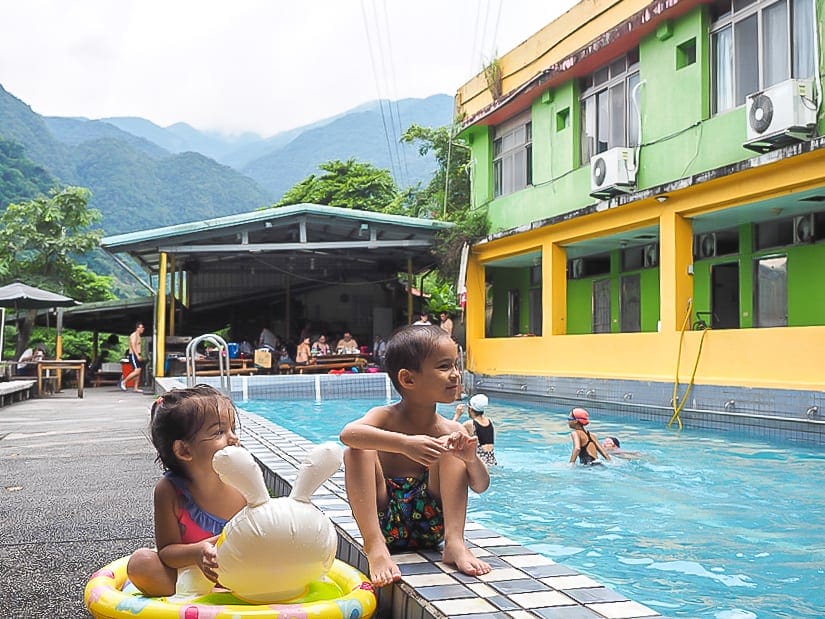
See more information about traveling in Taiwan with little ones in my articles on things to do in Taipei with kids and traveling around Taiwan with kids.
Budget Hot Spring Hotels in Wulai
The cheapest hotels in Wulai cost around TWD 2000 to 3000 for a double room. Shui An Hot Springs (see on Booking / Klook / Agoda) has rooms with hot tubs and private balconies looking over the river right in town.
51 Spring (see on Booking / Klook / TripAdvisor) is an even cheaper one on the same street, also with river view. Both hotels also offer rooms for 1-2 hours for hot spring soak only.
The above two are our favorite spots in Wulai for a cheap, private hot spring room. To get to either one from where the bus drops your off in Wulai, you’ll have to walk down the Old Street, cross the pedestrian bridge, and turn left. It takes 10-15 minutes walking.
If you want a hot spring hotel very close to the bus stop, Full Moon Spa (see on Booking / Klook / TripAdvisor) is right at the start of the Old Street.
Also see my guide to the best places to stay in Taipei City.
Wulai Hot Spring Spas
There are multiple hot spring spas & hotels right on Wulai Old Street, but most are quite old and rundown. You can see their prices advertised in window, and most have pictures showing what their public and private rooms look like. Some have river views, and some don’t.
Best Luxury Spas

For a luxury bathing experience, you can’t go wrong with the bathhouse or private rooms at the Volando Urai Spring Spa & Resort. Save money by booking online here.
Another luxury option just before the Old Street, but more expensive last time I checked, is this deal at Pause Landis.
For a real luxury experience in a remote natural location, Volando now runs Volando Trio, with a variety of private bathing options. You’ll need your own car to get there.
Best Budget Spas
We usually choose from the row of hot spring hotels that you can find by crossing Lansheng Bridge (the pedestrian bridge at the end of the Old Street, which goes over the river), and then turning left onto Wenquan Road in the direction of Wulai Waterfall.
These ones are just slightly more expensive than the ones on the Old Street. But most of them offer private soaking rooms with views of the river that are slightly better quality than the ones on the Old Street. 51 Spring (51溫泉會館, see location here), pictured below, is one of the cheapest and best. You can also spend the night in this hotel.

Wild Hot Springs in Wulai
The hot springs in Wulai come out of the ground at a very high temperature and are totally odorless and colorless. There are both semi-wild and hotel-run options in and around town.
Wulai Riverside Hot Springs

In the past, the main reason my friends and I used to visit Wulai was to soak in the collection of makeshift tubs at the riverside. As you can see in the photos here, these springs were immensely popular among locals.
Despite being rather disorganized and run-down, soaking in these springs was the quintessential Wulai experience. They were especially atmospheric in the evening as the sun went down, and one of the best parts was jumping into the cold Nanshi River from the rocks on the side.
These hot springs became increasingly rundown over time, though, and currently it is no longer possible to visit them.



To catch a peek at what’s left of these springs, you can view their former location from Lansheng Bridge (攬勝大橋, visible in photo above) over Nanshi River.
You may also be able to peer down from Wenquan Road (溫泉街), but note that is illegal to try to get down to them.

There is another spot by the river where hot water naturally bubbles out of the ground. To find it, turn left at the end of the bridge, and follow Wenquan Street (Hot Spring Street or 溫泉路) past a half dozen or so hot spring hotels.
When you see a parking lot on the left, follow it down to the riverside and you’ll likely see locals barbecuing by the river and soaking in simple pools made by arranging stones on the riverbank. You can even dig in the ground and make your own pool.
If you have a riverside barbecue here or at any of the other popular picnic spots on Nanshi River between Xindian and Wulai Old Street, please make sure to take your trash when you leave, even though many locals don’t.
Other Things to Do in Wulai
Hot springs aren’t the only reason to come to Wulai. If you’re wondering what to do in Wulai anytime of year, you’ll be spoiled for choices. Here are some ideas:
Stroll Wulai Old Street

The first thing you are likely to do upon arriving at Wulai is to walk down Wulai Old Street (烏來老街). The (mostly) pedestrian street starts at the Wulai Parkade and bridge over Tonghou River (桶後溪), a tributary of Nanshi River, then continues 250 meters south to Lansheng Bridge.

Along the street, visitors will encounter dozens of shops, restaurants, and food stalls hawking aboriginal-themed goods, tacky souvenirs, and loads of food. For an idea of some dishes you may encounter, see my guide to the 101 best local street foods in Taiwan.
They are very used to tourists here, and many hawkers will try to lure you in to sample their products (using patchy English or, if you are Asian, they’ll throw a variety of “hellos” in different Asian languages at you) .

Have you camera ready, as many of the items on display are particularly photogenic, and vendors mostly don’t care if you snap shots (a few have signs saying not to, though, and if they don’t, it is still best to ask first). The exotic fruit and vegetable display (you will likely see produce you never knew existed) at 老街山海產現炒小吃屋 (#78) is particularly photo-worthy.


Try Aboriginal Millet Wine

One of the aboriginal specialties that features prominently on Wulai Old Street is aboriginal millet wine (xiaomi jiu or 小米酒), a staple in aboriginal communities across Taiwan. The cloudy, sweet, and low alcohol (usually 5-10%) bottled drink is surprisingly palatable.
Shops sell dozens of varieties and are eager to let you sample while deciding whether to buy; I’ve gotten a pretty good buzz from this, just perfect before going for a hot spring soak!

There are also some stronger traditional spirits on offer, such as betel nut liqueur and distiller taro wine. Last time I visited, there was also a café at the entrance to Wulai Old Street selling maqaw-infused beers–very tasty!
Maqaw or magao / 馬告 is a lemony peppercorn that has therapeutic properties and is common as an ingredient in aboriginal cuisine across Taiwan, especially for cooking fish. If you take a seat to enjoy your beer, the vendor will even sprinkle some powdered maqaw on top.
Taste Authentic Aboriginal Food
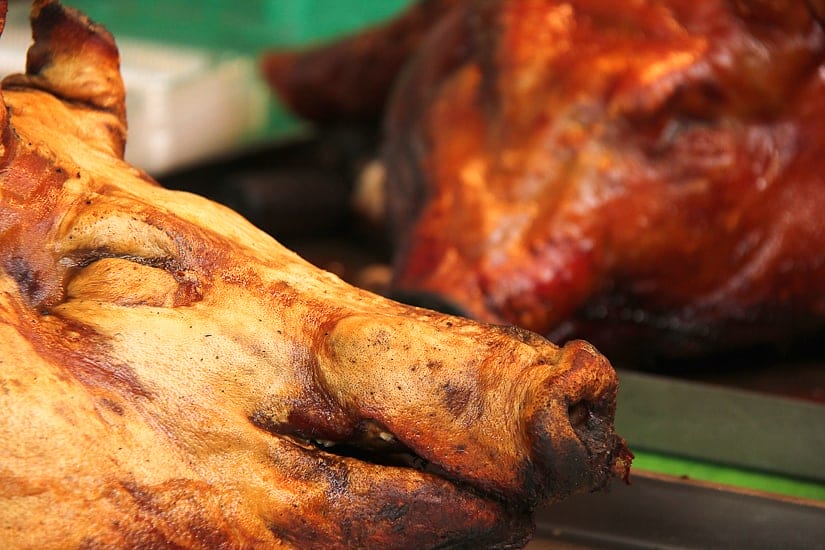
While this goes hand-in-hand with items #1 and #2, it still deserves its own entry because there is such so much delicious aboriginal food on offer on Wulai Old Street.
If you’re wondering where to eat in Wulai, just stroll down the street, and you will be tempted by displays of roasted wild boar (烤山豬肉), deep fried taro balls (炸芋頭), bamboo tubes stuffed with sticky rice (竹筒飯, carried by aboriginal hunters for convenience), and honeyed sweet potato (蜜蕃薯).



Take a seat in one of the restaurants on the old street, and you can enjoy a proper meal. Menus are long and varied and often the best stuff is displayed out front, but the local specialties you must try included aboriginal mountain greens, bamboo & tiger lily soup, and deep fried river shrimp and fish (to be eaten whole; tastier than it might sound!)
Related: Fried whole shrimps are also a specialty of Lukang Old Street in Central Taiwan, where they are called Monkey Shrimps!


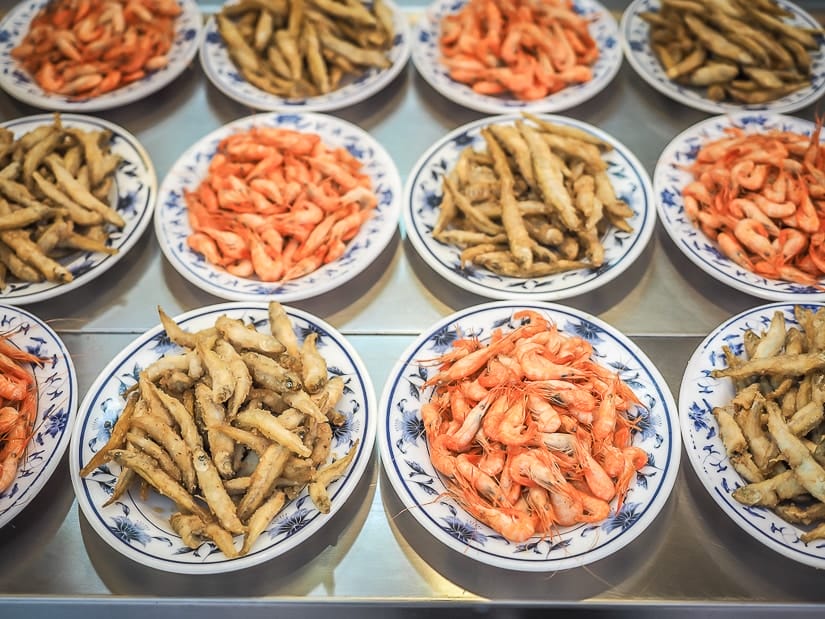
The best restaurants in Wulai along the old street include 泰雅婆婆美食店 (#14), 山地美食屋 (#20), 翡翠谷貓餐廳 (#26/28) and 烏來小吃店 (#91).
Besides aboriginal specialties, you can also find typical Taiwanese snacks like, grilled sausages, mochi, almond drinks, traditional pulled sugar candy, and stinky tofu (related: see my guide to Shenkeng Stinky tofu village, also in New Taipei City!)


Visit Wulai Atayal Museum

A few meters in from the entrance to Wulai Old Street on the river side of the road, you’ll find the Wulai Atayal Museum (烏來泰雅民族博物館), a four-story museum dedicated to the local aboriginal Atayal tribe. Watch for the large sculpture adorning the side of the building.
Inside you can find a decent collection of Atayal clothing, tools, and other displays with information in English. Also note the facial tattooing, a rite of passage and trademark of Atayal women, in several photos. What’s more, entrance to the museum is totally free.
Ride the Wulai Scenic Train (Wulai Log Cart)

After crossing Lansheng Bridge at the end of Wulai Old Street, look for the staircase going up to the Wulai Scenic Train station (烏來觀光台車). A short, 1.6-kilometer ride on a cute, colorful restored logging train costs around TWD50 each way. It’s not necessary, but you can pre-book your tickets here.
The train terminates at Wulai Waterfall and Wulai Gondola (see below). You can easily walk the same point by following riverside Wenquan Road (Hot Spring Road or 溫泉路), which turns into Pubu Road (Waterfall Road or 瀑布路).
According to some recent traveler reports, the train was closed for repairs (March 2024 note).
See Wulai Waterfall

Wulai Waterfall (烏來瀑布) is the tallest waterfall in Northern Taiwan. It is located a 20-minute walk (or short ride on the Wulai Scenic Train) south of Wulai Old Street, and falls 80 meters down a cliff on the opposite bank. The waterfall looks better after rain – in dry seasons, it is sometimes only a trickle.
There are further cascades higher up that are only visible if you ride the Wulai Gondola. The area around Wulai Waterfall is also a good spot to see cherry blossoms in late January and early February. Learn more in my Taiwan cherry blossom guide.
Ride the Wulai Gondola to Yunhsien Resort
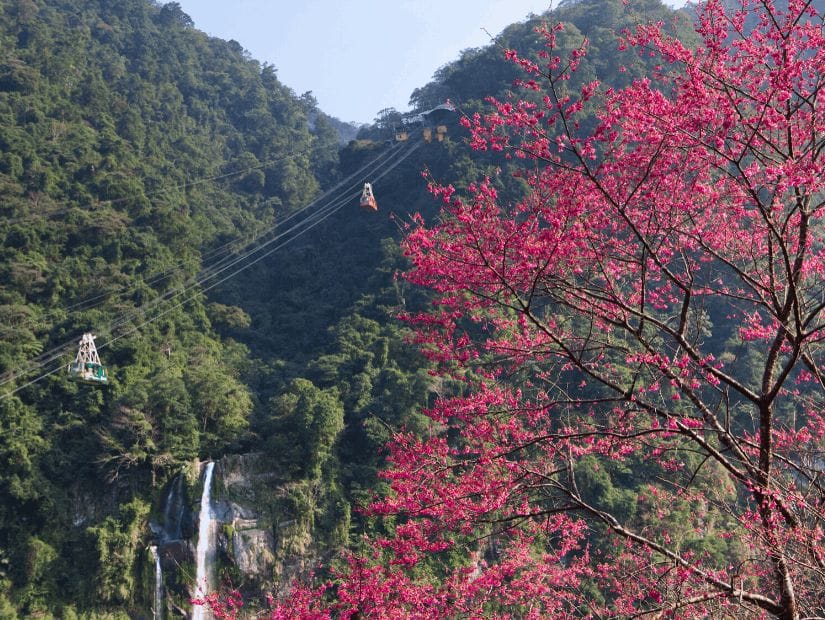
The Wulai Gondola (Wulai Cable Car or 烏來纜車) takes off from Taiche Waterfall Station (台車瀑布站).
The gondola travels right up over Wulai Waterfall to Yun Hsien Resort (雲仙樂園), an outdoor “amusement park” (don’t expect rides like at Taiwan’s larger amusement parks) that includes ponds with fish you can feed (bring coins), a few shrines, paintball and archery, gardens, a cafe and walking paths to a stream that you can swim in.
This cable car ticket includes entrance to the park. The park was heavily damaged in the 2015 typhoon, and to this day, its facilities are old, rundown, and feels almost abandoned.
Wulai Suspension Bridge

Heading back to the center of Wulai, 200 meters north of the Wulai Old Street parking lot, beautiful pedestrian-only Wulai Suspension Bridge (烏來吊橋) crosses Nanshi River.
The bridge offers fine views of Nanshi River Valley and Wulai Town, as well as providing access to Wulai Fude Temple (烏來福德宮) on the other side of the river.
Hiking in Wulai

There are numerous hikes that start or end in the Wulai Old Street area and more remote/less touristy Neidong Forest Recreation Area (內洞國家森林遊樂區) and Doll Valley (娃娃谷) a few kilometers to the south. Here are a few to consider (you can find even more in my Taipei hiking guide!):
- Xinxian Trail (信賢步道): An easy, mostly paved trail that follows the Nanshi River south of Wulai to Wulai Waterfall, Xinxian Waterfall, Wusha Creek Waterfall (烏紗溪瀑布), and Neidong Waterfall/Neidong Forest Recreation Area
- Neidong Forest Loop (內洞國家森林遊樂區觀瀑步道): An easy 2.9-kilometer waterfall trail four kilometers south of Wulai village in Neidong Forest Recreation Area. The trail takes in Wusha Creek Falls (烏紗溪瀑布) and beautiful Doll Valley , and could be done as a continuation of the Xinxian Trail.
- Tonghou Trail (桶後步道) A trail that follows the Tonghou River east of Wulai all the way to Jiaoxi Hot Spring village in Yilan County
- Badoer Mountain Trail (拔刀爾山步道): A moderate 5.8-kilometer hike up a mountain west of Wulai village
- It’s also possible to hike from Wulai all the way to Sanxia, another district in New Taipei City.
River Tracing in Wulai at Jiajiuliao Stream

Last but certainly not least, Wulai is one of the best places within easy reach of Taipei for doing river tracing (also known as river trekking). This awesome summer sport is very popular in Taiwan and involves walking up a river or creek, playing in pools of water, and jumping in wherever possible. The river tracing spot is actually the start of a hike that goes all the way from Wulai to Sanxia; read all about it in my guide to the best hikes around Taipei.
To get to Wulai’s awesome river trace, you’ll have to get off the Xindian-to-Wulai bus at Cheng Gong Bus Stop (成功站) about five minutes before reaching Wulai Old Street. It doesn’t hurt to let the driver know when boarding that you want to give off at this stop, so you don’t miss it.
From the tiny mom & pop shop at the bus stop, follow Jiajiuliao Street (加九寮路) downhill toward the river and cross red-colored Jiajiuliao Bridge. Follow the road a few minutes uphill on the other side until you reach a small bridge over Jiajiuliao Stream. From there, a trail starts to the left. Follow the trail a way upstream, and there are various points where you can get into the water and start tracing in either direction.
To go on an organized river trek, try this one in Yilan or this one in Taitung.
The highlight of the river trace is an awesome rockslide. You can’t miss it! The spot is very popular with local river tracing groups in summer. It is recommended to use a life jacket, helmet, and river tracing shoes, which are available at outdoors shops in Taipei. You can also follow the same trail for quite a ways to some waterfalls if you just want to go hiking.
The creekside near the trail entrance is also a popular spot for locals to have a riverside barbecue in summer, as are various points along the Nanshi River downstream from Wulai Old Street, and we often take our kids to these spots to play in the water. You just have to watch for spots to pull over and acces the river while driving in.
Well, that sums up all I’ve got to say about Wulai Hot Spring in Taiwan. Did you find all the info you needed? Let me know in the comments below if anything has changed in Wulai!



What a shame for the Wulai Public Hot Springs. I lived in Taiwan in 2014 and once of the things I was most looking for when I moved back recently was jumping from the Hot Springs directly into the river.